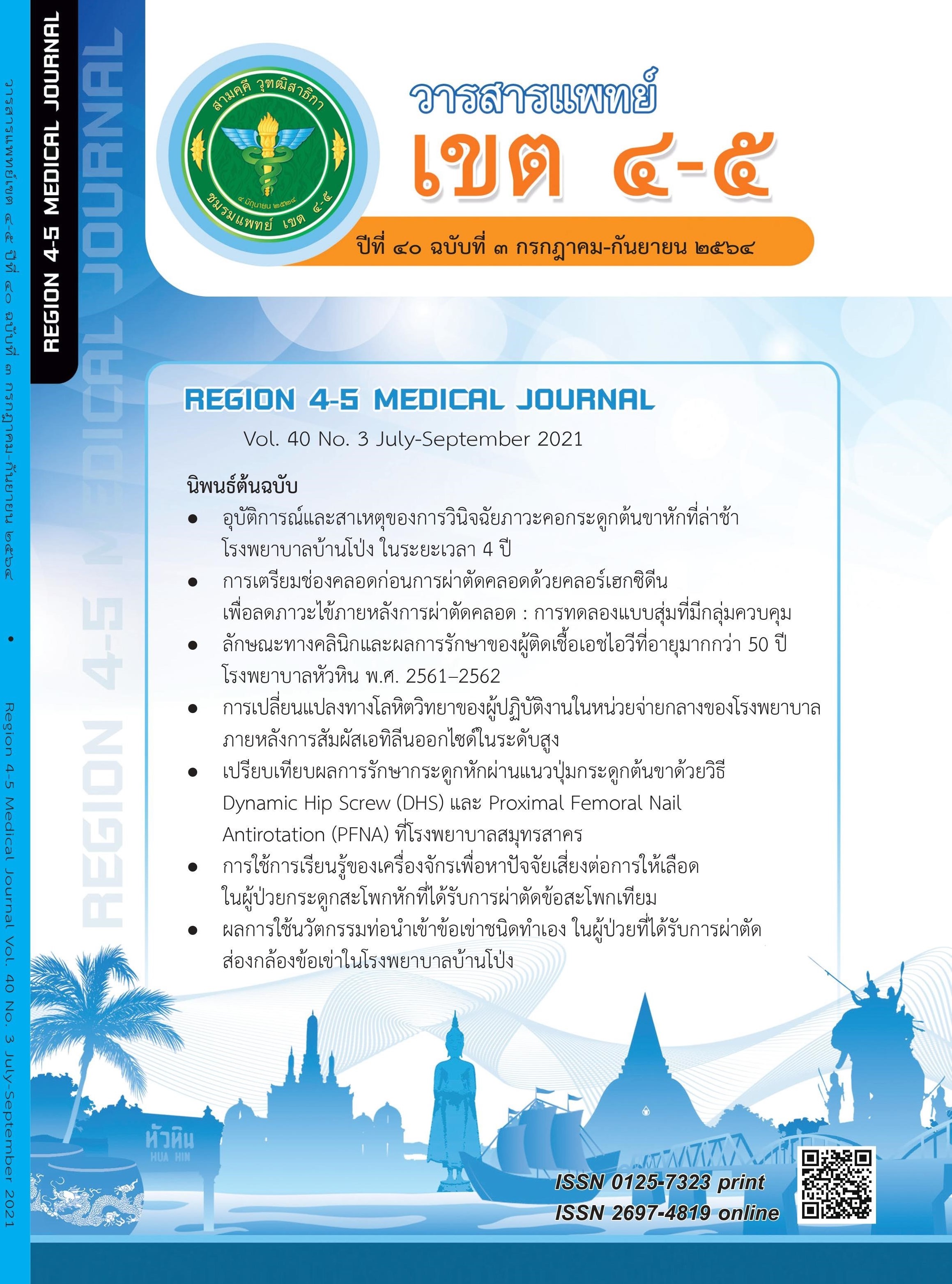ลักษณะทางคลินิกและผลการรักษาของผู้ติดเชื้อเอชไอวีที่อายุมากกว่า 50 ปี โรงพยาบาลหัวหิน พ.ศ. 2561 - 2562
คำสำคัญ:
เอชไอวี, เอดส์, ผู้สูงอายุ, โรคร่วม, ลักษณะทางคลินิกบทคัดย่อ
วัตถุประสงค์: ในปัจจุบันผู้ติดเชื้อเอชไอวีได้รับการรักษาด้วยยาต้านไวรัสอย่างต่อเนื่อง ทำให้ประชากรกลุ่มนี้มีชีวิตที่ยาวนานขึ้น รวมถึงพบภาวะโรคเรื้อรังต่างๆ ตามอายุที่มากขึ้นด้วย อย่างไรก็ตามข้อมูลเกี่ยวกับผู้สูงอายุที่ติดเชื้อเอชไอวียังมีอยู่จำกัด ดังนั้นวัตถุประสงค์ของงานวิจัยนี้ คือเพื่อศึกษาลักษณะทางคลินิก และการใช้บริการทางการแพทย์ต่าง ๆ ของประชากรกลุ่มนี้ รวมถึงประเมินประสิทธิภาพของการดูแลรักษา และปัจจัยที่เกี่ยวข้อง
วิธีการศึกษา: เป็นการศึกษาเชิงพรรณนาแบบย้อนหลัง โดยศึกษาข้อมูลผู้ติดเชื้อเอชไอวีที่อายุมากกว่า 50 ปี ตั้งแต่ 1 กรกฎาคม 2561 ถึง 30 มิถุนายน 2562 โดยเก็บข้อมูลจากเวชระเบียนอิเล็กทรอนิกส์ และวิเคราะห์ข้อมูลโดยใช้ Spearman correlation เพื่อหาความสัมพันธ์ระหว่างภาวะโรคร่วมที่ไม่เกี่ยวเนื่องกับเอดส์และการใช้บริการทางการแพทย์ด้านอื่นๆ ของโรงพยาบาล และใช้ chi-square และ Fisher exact test เพื่อหาปัจจัยที่สัมพันธ์กับประสิทธิภาพของการดูแลรักษาผู้ป่วยเอชไอวี
ผลการศึกษา: จากผู้เข้าร่วมการศึกษาทั้งหมด 307 คน พบว่าร้อยละ 49.2 มีภาวะโรคร่วมอย่างน้อย 1 โรค และร้อยละ 22.5 มีภาวะโรคร่วมมากกว่า 2 ชนิด โดยผู้ป่วยมารับการรักษาต่อเนื่องร้อยละ 94.5 และกดไวรัสสำเร็จร้อยละ 97.9 จากการวิเคราะห์ทางสถิติพบว่า จำนวนของภาวะโรคร่วมสัมพันธ์กับจำนวนยาที่ใช้ประจำ อัตราการใช้บริการแผนกผู้ป่วยนอก และการนอนโรงพยาบาล โดยเพศ อายุ และผล CD4 ล่าสุดเป็นปัจจัยที่มีผลต่อการมารับการรักษาต่อเนื่อง (retention in care) อย่างมีนัยสำคัญทางสถิติ (p-value < .05)
สรุป: จากผลการศึกษาแสดงถึงลักษณะทางคลินิกที่สำคัญของผู้สูงอายุที่ติดเชื้อเอชไอวี รวมถึงภาวะโรคร่วมที่ไม่เกี่ยวเนื่องกับเอดส์ และเนื่องจากการดูแลรักษาผู้ป่วยกลุ่มนี้มีความซับซ้อนมากกว่าผู้สูงอายุทั่วไป การดูแลสุขภาพแบบองค์รวมโดยทีมสหวิชาชีพจึงมีความสำคัญอย่างมาก เพื่อให้ผู้ติดเชื้อเอชไอวีมีชีวิตที่ยืนยาว และคุณภาพชีวิตที่ดีขึ้น
เอกสารอ้างอิง
2. May MT, Gompels M, Delpech V, Porter K, Orkin C, Kegg S, et al. Impact on life expectancy of HIV-1 positive individuals of CD4+ cell count and viral load response to antiretroviral therapy. AIDS (London, England) 2014;28(8):1193-202.
3. (UNAIDS) JUNPoHA. UNAIDS/PCB (39)/16.26 Agenda11: HIV and ageing 2016.
4. AVERT. HIV and AIDS in Thailand. 2020 [cited 2020 April 1,2020]; Available from: https://www.avert.org/professionals/hiv-around-world/asia-pacific/thailand
5. (UNAIDS) JUNPoHA. Thailand: 2018 Country Factsheet. 2018 [cited 2020 March 20]; Available from: https://www.unaids.org/en/regionscountries/countries/thailand.
6. Eduardo E, Lamb MR, Kandula S, et al. Characteristics and Outcomes among Older HIV-Positive Adults Enrolled in HIV Programs in Four Sub-Saharan African Countries. PLOS ONE 2014;9(7):e103864.
7. Wing EJ. HIV and aging. International Journal of Infectious Diseases 2016;53:61-8.
8. Patel P, Rose CE, Collins PY, et al. Noncommunicable diseases among HIV-infected persons in low-income and middle-income countries: a systematic review and meta-analysis. AIDS (London, England) 2018;32 Suppl 1(Suppl 1):S5-S20.
9. Bijker R, Choi JY, Ditangco R, et al. Cardiovascular Disease and Cardiovascular Disease Risk in HIV-Positive Populations in the Asian Region. The open AIDS journal 2017;11:52-66.
10. Schouten J, Wit FW, Stolte IG, et al. Cross-sectional Comparison of the Prevalence of Age-Associated Comorbidities and Their Risk Factors Between HIV-Infected and Uninfected Individuals: The AGEhIV Cohort Study. Clinical Infectious Diseases 2014;59(12):1787-97.
11. Guaraldi G, Orlando G, Zona S, et al. Premature Age-Related Comorbidities Among HIV-Infected Persons Compared With the General Population. Clinical Infectious Diseases 2011;53(11):1120-6.
12. Bureau of registration administration MoI, Thailand. Official Statistics Registration System. 2019 [cited 2020 April 1, 2020]; Available from: http://www.bora.dopa.go.th/index.php/th/
13. Fortin M, Stewart M, Poitras M-E, et al. A systematic review of prevalence studies on multimorbidity: toward a more uniform methodology. Annals of family medicine 2012;10(2):142-51.
14. Gnjidic D, Hilmer SN, Blyth FM, et al. Polypharmacy cutoff and outcomes: five or more medicines were used to identify community-dwelling older men at risk of different adverse outcomes. Journal of Clinical Epidemiology 2012;65(9):989-95.
15. Kay ES, Batey DS, Mugavero MJ. The HIV treatment cascade and care continuum: updates, goals, and recommendations for the future. AIDS research and therapy 2016;13:35-.
16. Team RC. R: A Language and Environment for Statistical Computing. Vienna, Austria: R Foundation for Statistical Computing; 2020.
17. Savasta A. HIV: Associated Transmission Risks in Older Adults–An Integrative Review of the Literature. The Journal of the Association of Nurses in AIDS Care : JANAC 2004;15:50-9.
18. Youssef E, Wright J, Delpech V, et al. Factors associated with testing for HIV in people aged ≥50 years: a qualitative study. BMC Public Health 2018;18(1):1204.
19. Asher I, Guri KM, Elbirt D, et al. Characteristics and Outcome of Patients Diagnosed With HIV at Older Age. Medicine 2016;95(1):e2327-e.
20. (UNAIDS) JUNPoHA. 90–90–90 - An ambitious treatment target to help end the AIDS epidemic. 2017 [1/10/2020]; Available from: https://www.unaids.org/en/resources/documents/2017/90-90-90
21. Koole O, Tsui S, Wabwire-Mangen F, et al. Retention and risk factors for attrition among adults in antiretroviral treatment programmes in Tanzania, Uganda and Zambia. Tropical medicine & international health : TM & IH 2014;19(12):1397-410.
22. Thida A, Tun STT, Zaw SKK, et al. Retention and risk factors for attrition in a large public health ART program in Myanmar: a retrospective cohort analysis. PloS one 2014;9(9):e108615-e.
23. Chinenye U, Nwanneka O, Patrick D, et al. Correlates of Patient Retention in HIV Care and Treatment Programs in Nigeria. Current HIV Research 2015;13(4):300-7.
24. Allam RR, Murhekar MV, Bhatnagar T , et al. Survival probability and predictors of mortality and retention in care among patients enrolled for first-line antiretroviral therapy, Andhra Pradesh, India, 2008–2011. Transactions of The Royal Society of Tropical Medicine and Hygiene 2014;108(4):198-205.
25. Ruzicka DJ, Imai K, Takahashi K, et al. Comorbidities and the use of comedications in people living with HIV on antiretroviral therapy in Japan: a cross-sectional study using a hospital claims database. BMJ Open 2018;8(6):e019985.
26. Wu P-Y, Chen M-Y, Hsieh S-M, et al. Comorbidities among the HIV-infected patients aged 40 years or older in Taiwan. PloS one 2014;9(8):e104945-e.
27. Nakaranurack C, Manosuthi W. Prevalence of Non-AIDS Comorbidities and Factors Associated with Metabolic Complications among HIV-Infected Patients at a Thai Referral Hospital. Journal of the International Association of Providers of AIDS Care 2018;17:2325957417752256-.
28. Wong C, Gange SJ, Moore RD, et al. Multimorbidity Among Persons Living with Human Immunodeficiency Virus in the United States. Clinical Infectious Diseases 2017;66(8):1230-8.
29. Serrão R, Piñero C, Velez J, et al. Non-AIDS-related comorbidities in people living with HIV-1 aged 50 years and older: The AGING POSITIVE study. International Journal of Infectious Diseases 2019;79:94-100.
30. Lachaine J, Baribeau V, Lorgeoux R, et al. Health Care Resource Utilization And Costs Associated With HIV-Positive Patients With Comorbidity Versus HIV-Negative Patients With Comorbidity. Value in Health 2017;20(9):A791.
ดาวน์โหลด
เผยแพร่แล้ว
รูปแบบการอ้างอิง
ฉบับ
ประเภทบทความ
สัญญาอนุญาต
ลิขสิทธิ์บทความเป็นของผู้เขียนบทความ แต่หากผลงานของท่านได้รับการพิจารณาตีพิมพ์ลงวารสารแพทย์เขต 4-5 จะคงไว้ซึ่งสิทธิ์ในการตีพิมพ์ครั้งแรกด้วยเหตุที่บทความจะปรากฎในวารสารที่เข้าถึงได้ จึงอนุญาตให้นำบทความในวารสารไปใช้ประโยชน์ได้ในเชิงวิชาการโดยจำเป็นต้องมีการอ้างอิงถึงชื่อวารสารอย่างถูกต้อง แต่ไม่อนุญาตให้นำไปใช้ในเชิงพาณิชย์




